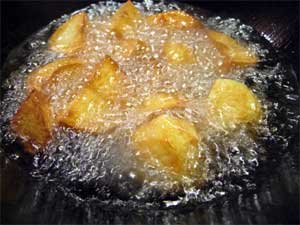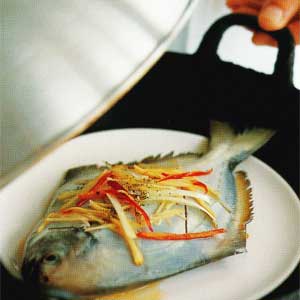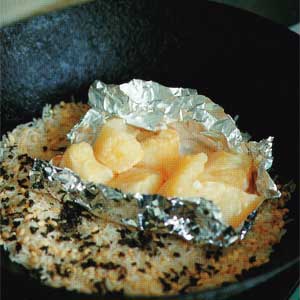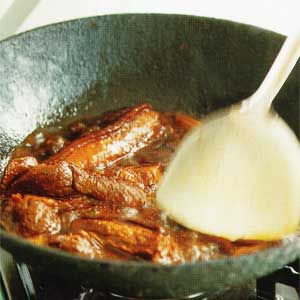The wok’s versatility obviates the need for a battery of utensils for different methods of cookery, but it is helpful to have two woks, of 25 cm (10 inches) and 35 cm (14 inches) diameter. The larger one is better for holding bamboo steamers and for smoking, while the smaller wok can be used for deep-frying and braising. When storing, they can be stacked one in the other, thus taking up less kitchen space.
Wok for Deep-frying

The wok’s curvature means that it demands much less oil to deep-fry than does a conventional deep-fryer. Always choose an oil with a high smoke point for deep-frying and stir-frying. Peanut (groundnut) oil (the preferred choice of Chinese cooks), rapeseed (canola) oil and light olive oil (not extra virgin) are all good choices. Place a draining rack on the side of the wok. Add oil to a depth of one-third, and heat. Fry only a few pieces of food at a time. When done, remove each item, holding it at an angle so that the excess oil drains away. Sit on the draining rack to drain completely.
Steaming with a wok

To steam foods in a wok, simply place the food on a dish resting on the steaming trivet. Choose a dish large enough to sit steadily on the trivet, but allow room at the sides for easy removal. Fill the wok with water, making sure that it does not touch the base of the dish. Bring to the boil, cover with the wok lid and let the steam circulate. Alternatively, use a bamboo steamer of a slightly smaller diameter than the wok. Ensure that it sits at least 4cm (1¾ inches) above the water level, and cover with the steamer’s lid.
Wok for Tea-smoking

Smoking is a slow, gentle heat process for cooking and flavoring foods that are not too thick or chunky, such as fish or thin slices of meat and poultry. Fill the wok to a depth of one-third with uncooked rice mixed with a few handfuls of barley grains. Sprinkle over 1 tbsp black or green tea leaves. Sit the food on a double layer of foil, wrap firmly and lay it directly on the grains. Cover with the wok lid, and smoke over a low heat for about 1 hour, opening the foil parcel for the last 30 minutes of cooking. Avoid using highly flavoured teas such as lapsang souchong for smoking.
Wok for Braising

This wok cooking technique involves cooking food gently in a flavorsome liquid in a closed container. The liquid should just cover the main ingredients; the long, gentle simmering process will reduce it by about half. Open the lid occasionally during cooking, and top up with a little liquid if it is too dry. Remove the food when it is cooked, and reduce the sauce further by boiling vigorously until thickened, which intensifies its flavor.
